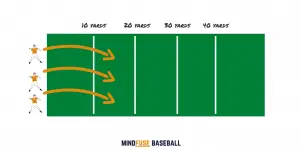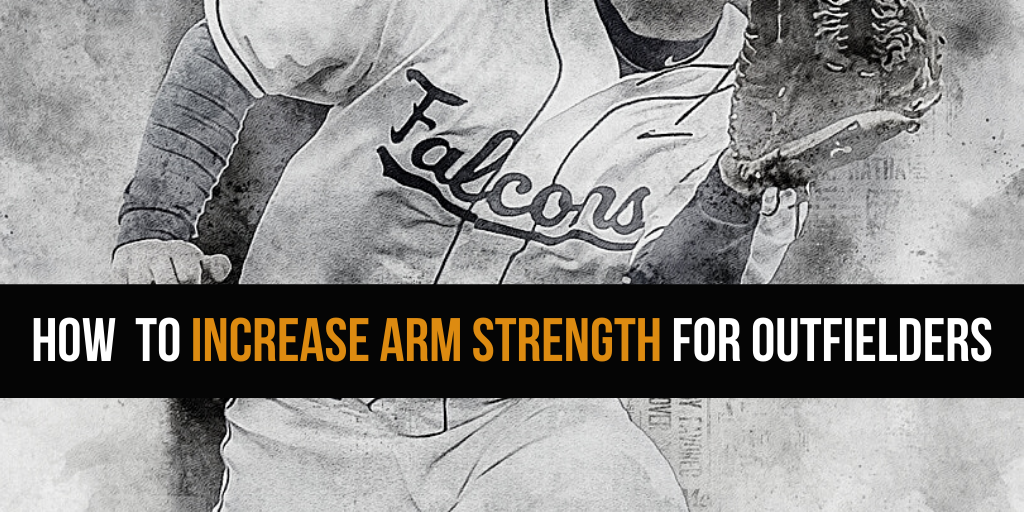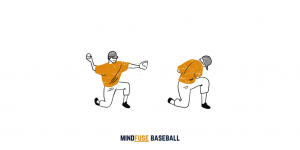As an outfielder, it’s guaranteed that you’re going to have to make some pretty impressive and lengthy throws during a game.
Imagine the situation – you’re playing center field and the ball comes in your direction just as an opposition runner is rounding third and heading for home. If they make it, they’ll score a run so it’s down to you to deliver the throw that cuts them off.
Failure to make the distance can be crushing, so how can you make sure that your throws are reaching their desired target every time? The answer – increase your arm strength.
There are a few tips and tricks that you can use to improve your arm strength. That’s why we’ve put together this article to highlight the best ways to get a longer and more powerful throw. They range from actual throwing drills to improve technique to gym exercises that will help increase physical strength and athleticism.
Before we get down to the nitty-gritty of how to increase your arm strength it’s important to remember that your conditioning drills routine has to be well-planned and safe.
Building muscle strength doesn’t happen overnight – it takes time, patience, and dedication. It’s good to put your body through its paces when training but you should never overload your muscles or push yourself too hard – this is only going to lead to injuries and leave you watching from the sidelines.
Always carry out a thorough warm-up before starting these practice drills or hitting the weights – stretch, breathe and enjoy the workout.
So, away from training on the field, and studying the opposition and even taking your throws to a rebound net – what can you do to increase your arm strength specifically? Well, let’s take a look at the very best ways to increase your arm strength starting with the simplest idea of all…
Long Toss

This is one of the most obvious ways that baseball players can increase their arm strength. If you’ve got a partner, you can play long toss whenever the mood takes you. We’ve all played it before, I’m sure, so you should know how simple the concept is – throw and catch the ball with your friend – or on your own. All you need is a ball and glove.
Take it easy, to begin with, however, and start off throwing at a short distance.
With every successful throw, take a couple of steps apart from your partner and repeat the process. When you reach your limit, don’t force it any further. Stay at your comfortable maximum distance for a few more throws before coming back in again as a cool down.
If you do this every few days for a month, you’re guaranteed to see results. Your throw will be longer and your arm will definitely feel stronger.
One Knee Long Toss
Essentially, this is the same drill only with the handicap of dropping your rear knee. This is going to restrict your lower body – you won’t be able to stride into your throw.
What’s important here is that your upper body technique and throwing mechanics are on point. The drill encourages fluid rotation at the shoulder and hips – jerky, force throwing should be avoided. You won’t be able to throw as far as usual but it’s a surefire way of training your upper body to add more power and distance to your throws.
Remember, this is all about using proper mechanics to condition your muscles so you don’t have to throw the ball extraordinary distances – just do what feels comfortable and increase the length gradually over time.
Kneeling Single-Arm Cable Press
This is a great gym-based workout that will work your shoulder muscles. Drop onto one knee with your back to the cable machine. Take the handle and push directly forwards with controlled force keeping a straight, horizontal line.
Select a manageable weight. This shouldn’t be too heavy as the repetitions need to be done comfortably at speed. If the weight is too heavy and you’re struggling to even lift it, it’s going to cause more damage than good. The weight should just provide a small amount of resistance to make it worthwhile.
Dumbbell Routine
This dumbbell routine is perfect for working on all of the large muscle groups that go into throwing a ball. It incorporates the shoulders, rotator cuff, and chest and it will definitely leave you feeling like you’ve had a decent workout.
Avoid going in with super heavy weights – start off small and build it up gradually. These exercises aren’t about bodybuilding – they’re designed for small weights to strengthen your throwing muscles without turning you into The Hulk.
Stretch
Raw power is one thing that we all want as outfielders, but that power needs to be coupled with flexibility in order to really be effective. If your arm is limber, chances are that you’ll be able to throw a baseball much further.
You’d be wrong to think that stretching is exclusively for warming up before a game or training session. Stretching more often is going to be beneficial to your throwing arm and help develop the flex in your muscle fibers making them stronger and able to work at higher intensities.
Vertical and horizontal arm swings are good to get started. You should also try forward and backward full arm rotations. If you can find 5-10 minutes every day to stretch, you’ll soon notice the difference in your arms and your ability to throw further will go through the roof.
Get a Pull-Up Bar
One of the best pieces of workout equipment you can invest in is a pull-up bar. They’ve affordable and easy to set up anywhere. If you put one up in the doorway of your bedroom and incorporate 5 reps into your daily stretching routine, you’ll really develop some strength in your arms, shoulders, and chest as well as your core, all of which will help you throw further.
Weighted Balls
In our opinion, weighted balls are one of the simplest and best training aids out there. Throwing them at a target or playing long toss with a partner with a weighted ball is a surefire way to increase your arm strength.
As always with weights, don’t overdo it. Take it easy and don’t try to hit crazy distances because it’s only going to lead to you throwing out your shoulder. Always make sure that you’re throwing safely by focussing on your technique rather than force. Younger players using weighted balls should always be supervised by an adult so that drills can be carried out sensibly.

![Baseball Drills for 5 Year Olds: Throw The Goalie [MindfuseBaseball.com]](https://mindfusebaseball.com/wp-content/uploads/2020/04/Baseball-Drills-for-5-Year-Olds_-Throw-The-Goalie-2-300x150.png)
